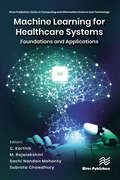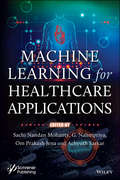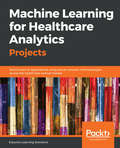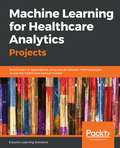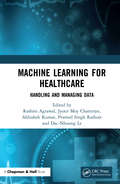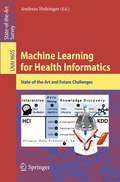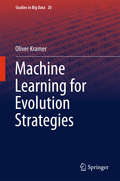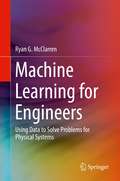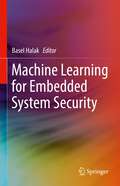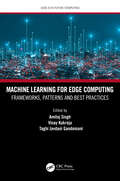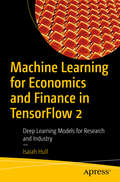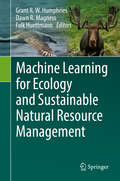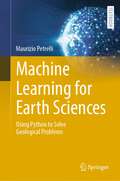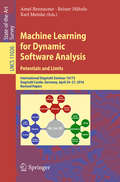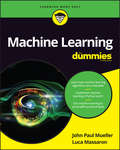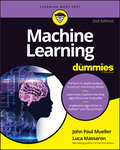- Table View
- List View
Machine Learning for Imbalanced Data: Tackle imbalanced datasets using machine learning and deep learning techniques
by Kumar Abhishek Dr. Mounir AbdelazizTake your machine learning expertise to the next level with this essential guide, utilizing libraries like imbalanced-learn, PyTorch, scikit-learn, pandas, and NumPy to maximize model performance and tackle imbalanced dataKey FeaturesUnderstand how to use modern machine learning frameworks with detailed explanations, illustrations, and code samplesLearn cutting-edge deep learning techniques to overcome data imbalanceExplore different methods for dealing with skewed data in ML and DL applicationsPurchase of the print or Kindle book includes a free eBook in the PDF formatBook DescriptionAs machine learning practitioners, we often encounter imbalanced datasets in which one class has considerably fewer instances than the other. Many machine learning algorithms assume an equilibrium between majority and minority classes, leading to suboptimal performance on imbalanced data. This comprehensive guide helps you address this class imbalance to significantly improve model performance. Machine Learning for Imbalanced Data begins by introducing you to the challenges posed by imbalanced datasets and the importance of addressing these issues. It then guides you through techniques that enhance the performance of classical machine learning models when using imbalanced data, including various sampling and cost-sensitive learning methods. As you progress, you’ll delve into similar and more advanced techniques for deep learning models, employing PyTorch as the primary framework. Throughout the book, hands-on examples will provide working and reproducible code that’ll demonstrate the practical implementation of each technique. By the end of this book, you’ll be adept at identifying and addressing class imbalances and confidently applying various techniques, including sampling, cost-sensitive techniques, and threshold adjustment, while using traditional machine learning or deep learning models.What you will learnUse imbalanced data in your machine learning models effectivelyExplore the metrics used when classes are imbalancedUnderstand how and when to apply various sampling methods such as over-sampling and under-samplingApply data-based, algorithm-based, and hybrid approaches to deal with class imbalanceCombine and choose from various options for data balancing while avoiding common pitfallsUnderstand the concepts of model calibration and threshold adjustment in the context of dealing with imbalanced datasetsWho this book is forThis book is for machine learning practitioners who want to effectively address the challenges of imbalanced datasets in their projects. Data scientists, machine learning engineers/scientists, research scientists/engineers, and data scientists/engineers will find this book helpful. Though complete beginners are welcome to read this book, some familiarity with core machine learning concepts will help readers maximize the benefits and insights gained from this comprehensive resource.
Machine Learning for Healthcare Systems: Foundations and Applications (River Publishers Series in Computing and Information Science and Technology)
by C. Karthik Chandran M. Rajalakshmi Sachi Nandan Mohanty Subrata ChowdhuryThe introduction of digital technology in the healthcare industry is marked by ongoing difficulties with implementation and use. Slow progress has been made in unifying different healthcare systems, and much of the world still lacks a fully integrated healthcare system. The intrinsic complexity and development of human biology, as well as the differences across patients, have repeatedly demonstrated the significance of the human element in the diagnosis and treatment of illnesses. But as digital technology develops, healthcare providers will undoubtedly need to use it more and more to give patients the best treatment possible. The extensive use of machine learning in numerous industries, including healthcare, has been made possible by advancements in data technologies, including storage capacity, processing capability, and data transit speeds. The need for a personalized medicine or "precision medicine" approach to healthcare has been highlighted by current trends in medicine due to the complexity of providing effective healthcare to each individual. Personalized medicine aims to identify, forecast, and analyze diagnostic decisions using vast volumes of healthcare data so that doctors may then apply them to each unique patient. These data may include, but are not limited to, information on a person’s genes or family history, medical imaging data, drug combinations, patient health outcomes at the community level, and natural language processing of pre-existing medical documentation. This book provides various insights into machine learning techniques in healthcare system data and its analysis. Recent technological advancements in the healthcare system represent cutting-edge innovations and global research successes in performance modelling, analysis, and applications.
Machine Learning for Healthcare Systems: Foundations and Applications (River Publishers Series in Computing and Information Science and Technology)
by C. Karthik M. Rajalakshmi Sachi Nandan Mohanty Subrata ChowdhuryThe introduction of digital technology in the healthcare industry is marked by ongoing difficulties with implementation and use. Slow progress has been made in unifying different healthcare systems, and much of the world still lacks a fully integrated healthcare system. The intrinsic complexity and development of human biology, as well as the differences across patients, have repeatedly demonstrated the significance of the human element in the diagnosis and treatment of illnesses. But as digital technology develops, healthcare providers will undoubtedly need to use it more and more to give patients the best treatment possible. The extensive use of machine learning in numerous industries, including healthcare, has been made possible by advancements in data technologies, including storage capacity, processing capability, and data transit speeds. The need for a personalized medicine or "precision medicine" approach to healthcare has been highlighted by current trends in medicine due to the complexity of providing effective healthcare to each individual. Personalized medicine aims to identify, forecast, and analyze diagnostic decisions using vast volumes of healthcare data so that doctors may then apply them to each unique patient. These data may include, but are not limited to, information on a person’s genes or family history, medical imaging data, drug combinations, patient health outcomes at the community level, and natural language processing of pre-existing medical documentation. This book provides various insights into machine learning techniques in healthcare system data and its analysis. Recent technological advancements in the healthcare system represent cutting-edge innovations and global research successes in performance modelling, analysis, and applications.
Machine Learning for Healthcare Applications
by Sachi Nandan Mohanty G. Nalinipriya Om Prakash Jena Achyuth SarkarWhen considering the idea of using machine learning in healthcare, it is a Herculean task to present the entire gamut of information in the field of intelligent systems. It is, therefore the objective of this book to keep the presentation narrow and intensive. This approach is distinct from others in that it presents detailed computer simulations for all models presented with explanations of the program code. It includes unique and distinctive chapters on disease diagnosis, telemedicine, medical imaging, smart health monitoring, social media healthcare, and machine learning for COVID-19. These chapters help develop a clear understanding of the working of an algorithm while strengthening logical thinking. In this environment, answering a single question may require accessing several data sources and calling on sophisticated analysis tools. While data integration is a dynamic research area in the database community, the specific needs of research have led to the development of numerous middleware systems that provide seamless data access in a result-driven environment. Since this book is intended to be useful to a wide audience, students, researchers and scientists from both academia and industry may all benefit from this material. It contains a comprehensive description of issues for healthcare data management and an overview of existing systems, making it appropriate for introductory and instructional purposes. Prerequisites are minimal; the readers are expected to have basic knowledge of machine learning. This book is divided into 22 real-time innovative chapters which provide a variety of application examples in different domains. These chapters illustrate why traditional approaches often fail to meet customers’ needs. The presented approaches provide a comprehensive overview of current technology. Each of these chapters, which are written by the main inventors of the presented systems, specifies requirements and provides a description of both the chosen approach and its implementation. Because of the self-contained nature of these chapters, they may be read in any order. Each of the chapters use various technical terms which involve expertise in machine learning and computer science.
Machine Learning for Healthcare Applications
by Sachi Nandan Mohanty G. Nalinipriya Om Prakash Jena Achyuth SarkarWhen considering the idea of using machine learning in healthcare, it is a Herculean task to present the entire gamut of information in the field of intelligent systems. It is, therefore the objective of this book to keep the presentation narrow and intensive. This approach is distinct from others in that it presents detailed computer simulations for all models presented with explanations of the program code. It includes unique and distinctive chapters on disease diagnosis, telemedicine, medical imaging, smart health monitoring, social media healthcare, and machine learning for COVID-19. These chapters help develop a clear understanding of the working of an algorithm while strengthening logical thinking. In this environment, answering a single question may require accessing several data sources and calling on sophisticated analysis tools. While data integration is a dynamic research area in the database community, the specific needs of research have led to the development of numerous middleware systems that provide seamless data access in a result-driven environment. Since this book is intended to be useful to a wide audience, students, researchers and scientists from both academia and industry may all benefit from this material. It contains a comprehensive description of issues for healthcare data management and an overview of existing systems, making it appropriate for introductory and instructional purposes. Prerequisites are minimal; the readers are expected to have basic knowledge of machine learning. This book is divided into 22 real-time innovative chapters which provide a variety of application examples in different domains. These chapters illustrate why traditional approaches often fail to meet customers’ needs. The presented approaches provide a comprehensive overview of current technology. Each of these chapters, which are written by the main inventors of the presented systems, specifies requirements and provides a description of both the chosen approach and its implementation. Because of the self-contained nature of these chapters, they may be read in any order. Each of the chapters use various technical terms which involve expertise in machine learning and computer science.
Machine Learning for Healthcare Analytics Projects: Build smart AI applications using neural network methodologies across the healthcare vertical market
by Eduonix Learning SolutionsCreate real-world machine learning solutions using NumPy, pandas, matplotlib, and scikit-learn Key Features Develop a range of healthcare analytics projects using real-world datasets Implement key machine learning algorithms using a range of libraries from the Python ecosystem Accomplish intermediate-to-complex tasks by building smart AI applications using neural network methodologies Book Description Machine Learning (ML) has changed the way organizations and individuals use data to improve the efficiency of a system. ML algorithms allow strategists to deal with a variety of structured, unstructured, and semi-structured data. Machine Learning for Healthcare Analytics Projects is packed with new approaches and methodologies for creating powerful solutions for healthcare analytics. This book will teach you how to implement key machine learning algorithms and walk you through their use cases by employing a range of libraries from the Python ecosystem. You will build five end-to-end projects to evaluate the efficiency of Artificial Intelligence (AI) applications for carrying out simple-to-complex healthcare analytics tasks. With each project, you will gain new insights, which will then help you handle healthcare data efficiently. As you make your way through the book, you will use ML to detect cancer in a set of patients using support vector machines (SVMs) and k-Nearest neighbors (KNN) models. In the final chapters, you will create a deep neural network in Keras to predict the onset of diabetes in a huge dataset of patients. You will also learn how to predict heart diseases using neural networks. By the end of this book, you will have learned how to address long-standing challenges, provide specialized solutions for how to deal with them, and carry out a range of cognitive tasks in the healthcare domain. What you will learn Explore super imaging and natural language processing (NLP) to classify DNA sequencing Detect cancer based on the cell information provided to the SVM Apply supervised learning techniques to diagnose autism spectrum disorder (ASD) Implement a deep learning grid and deep neural networks for detecting diabetes Analyze data from blood pressure, heart rate, and cholesterol level tests using neural networks Use ML algorithms to detect autistic disorders Who this book is for Machine Learning for Healthcare Analytics Projects is for data scientists, machine learning engineers, and healthcare professionals who want to implement machine learning algorithms to build smart AI applications. Basic knowledge of Python or any programming language is expected to get the most from this book.
Machine Learning for Healthcare Analytics Projects: Build smart AI applications using neural network methodologies across the healthcare vertical market
by Eduonix Learning SolutionsCreate real-world machine learning solutions using NumPy, pandas, matplotlib, and scikit-learn Key Features Develop a range of healthcare analytics projects using real-world datasets Implement key machine learning algorithms using a range of libraries from the Python ecosystem Accomplish intermediate-to-complex tasks by building smart AI applications using neural network methodologies Book Description Machine Learning (ML) has changed the way organizations and individuals use data to improve the efficiency of a system. ML algorithms allow strategists to deal with a variety of structured, unstructured, and semi-structured data. Machine Learning for Healthcare Analytics Projects is packed with new approaches and methodologies for creating powerful solutions for healthcare analytics. This book will teach you how to implement key machine learning algorithms and walk you through their use cases by employing a range of libraries from the Python ecosystem. You will build five end-to-end projects to evaluate the efficiency of Artificial Intelligence (AI) applications for carrying out simple-to-complex healthcare analytics tasks. With each project, you will gain new insights, which will then help you handle healthcare data efficiently. As you make your way through the book, you will use ML to detect cancer in a set of patients using support vector machines (SVMs) and k-Nearest neighbors (KNN) models. In the final chapters, you will create a deep neural network in Keras to predict the onset of diabetes in a huge dataset of patients. You will also learn how to predict heart diseases using neural networks. By the end of this book, you will have learned how to address long-standing challenges, provide specialized solutions for how to deal with them, and carry out a range of cognitive tasks in the healthcare domain. What you will learn Explore super imaging and natural language processing (NLP) to classify DNA sequencing Detect cancer based on the cell information provided to the SVM Apply supervised learning techniques to diagnose autism spectrum disorder (ASD) Implement a deep learning grid and deep neural networks for detecting diabetes Analyze data from blood pressure, heart rate, and cholesterol level tests using neural networks Use ML algorithms to detect autistic disorders Who this book is for Machine Learning for Healthcare Analytics Projects is for data scientists, machine learning engineers, and healthcare professionals who want to implement machine learning algorithms to build smart AI applications. Basic knowledge of Python or any programming language is expected to get the most from this book.
Machine Learning for Healthcare Analytics Projects: Build Smart Ai Applications Using Neural Network Methodologies Across The Healthcare Vertical Market
by Eduonix Learning SolutionsMachine learning in the healthcare domain is booming because of its abilities to provide accurate and stabilized techniques. This book is packed with new methodologies to create efficient solutions for healthcare analytics. We will build 6 end-to-end projects to evaluate the efficiency of AI apps to carry out simple-to-complex healthcare analytics tasks.
Machine Learning for Healthcare: Handling and Managing Data
by Dac-Nhuong Le Rashmi Agrawal Jyotir Moy Chatterjee Abhishek Kumar Pramod Singh RathoreMachine Learning for Healthcare: Handling and Managing Data provides in-depth information about handling and managing healthcare data through machine learning methods. This book expresses the long-standing challenges in healthcare informatics and provides rational explanations of how to deal with them. Machine Learning for Healthcare: Handling and Managing Data provides techniques on how to apply machine learning within your organization and evaluate the efficacy, suitability, and efficiency of machine learning applications. These are illustrated in a case study which examines how chronic disease is being redefined through patient-led data learning and the Internet of Things. This text offers a guided tour of machine learning algorithms, architecture design, and applications of learning in healthcare. Readers will discover the ethical implications of machine learning in healthcare and the future of machine learning in population and patient health optimization. This book can also help assist in the creation of a machine learning model, performance evaluation, and the operationalization of its outcomes within organizations. It may appeal to computer science/information technology professionals and researchers working in the area of machine learning, and is especially applicable to the healthcare sector. The features of this book include: A unique and complete focus on applications of machine learning in the healthcare sector. An examination of how data analysis can be done using healthcare data and bioinformatics. An investigation of how healthcare companies can leverage the tapestry of big data to discover new business values. An exploration of the concepts of machine learning, along with recent research developments in healthcare sectors.
Machine Learning for Healthcare: Handling and Managing Data
by Rashmi Agrawal, Jyotir Moy Chatterjee, Abhishek Kumar, Pramod Singh Rathore and Dac-Nhuong LeMachine Learning for Healthcare: Handling and Managing Data provides in-depth information about handling and managing healthcare data through machine learning methods. This book expresses the long-standing challenges in healthcare informatics and provides rational explanations of how to deal with them. Machine Learning for Healthcare: Handling and Managing Data provides techniques on how to apply machine learning within your organization and evaluate the efficacy, suitability, and efficiency of machine learning applications. These are illustrated in a case study which examines how chronic disease is being redefined through patient-led data learning and the Internet of Things. This text offers a guided tour of machine learning algorithms, architecture design, and applications of learning in healthcare. Readers will discover the ethical implications of machine learning in healthcare and the future of machine learning in population and patient health optimization. This book can also help assist in the creation of a machine learning model, performance evaluation, and the operationalization of its outcomes within organizations. It may appeal to computer science/information technology professionals and researchers working in the area of machine learning, and is especially applicable to the healthcare sector. The features of this book include: A unique and complete focus on applications of machine learning in the healthcare sector. An examination of how data analysis can be done using healthcare data and bioinformatics. An investigation of how healthcare companies can leverage the tapestry of big data to discover new business values. An exploration of the concepts of machine learning, along with recent research developments in healthcare sectors.
Machine Learning for Health Informatics: State-of-the-Art and Future Challenges (Lecture Notes in Computer Science #9605)
by Andreas HolzingerMachine learning (ML) is the fastest growing field in computer science, and Health Informatics (HI) is amongst the greatest application challenges, providing future benefits in improved medical diagnoses, disease analyses, and pharmaceutical development. However, successful ML for HI needs a concerted effort, fostering integrative research between experts ranging from diverse disciplines from data science to visualization. Tackling complex challenges needs both disciplinary excellence and cross-disciplinary networking without any boundaries. Following the HCI-KDD approach, in combining the best of two worlds, it is aimed to support human intelligence with machine intelligence. This state-of-the-art survey is an output of the international HCI-KDD expert network and features 22 carefully selected and peer-reviewed chapters on hot topics in machine learning for health informatics; they discuss open problems and future challenges in order to stimulate further research and international progress in this field.
Machine Learning for Evolution Strategies (Studies in Big Data #20)
by Oliver KramerThis book introduces numerous algorithmic hybridizations between both worlds that show how machine learning can improve and support evolution strategies. The set of methods comprises covariance matrix estimation, meta-modeling of fitness and constraint functions, dimensionality reduction for search and visualization of high-dimensional optimization processes, and clustering-based niching. After giving an introduction to evolution strategies and machine learning, the book builds the bridge between both worlds with an algorithmic and experimental perspective. Experiments mostly employ a (1+1)-ES and are implemented in Python using the machine learning library scikit-learn. The examples are conducted on typical benchmark problems illustrating algorithmic concepts and their experimental behavior. The book closes with a discussion of related lines of research.
Machine Learning for Engineers: Using data to solve problems for physical systems
by Ryan G. McClarrenAll engineers and applied scientists will need to harness the power of machine learning to solve the highly complex and data intensive problems now emerging. This text teaches state-of-the-art machine learning technologies to students and practicing engineers from the traditionally “analog” disciplines—mechanical, aerospace, chemical, nuclear, and civil. Dr. McClarren examines these technologies from an engineering perspective and illustrates their specific value to engineers by presenting concrete examples based on physical systems. The book proceeds from basic learning models to deep neural networks, gradually increasing readers’ ability to apply modern machine learning techniques to their current work and to prepare them for future, as yet unknown, problems. Rather than taking a black box approach, the author teaches a broad range of techniques while conveying the kinds of problems best addressed by each. Examples and case studies in controls, dynamics, heat transfer, and other engineering applications are implemented in Python and the libraries scikit-learn and tensorflow, demonstrating how readers can apply the most up-to-date methods to their own problems. The book equally benefits undergraduate engineering students who wish to acquire the skills required by future employers, and practicing engineers who wish to expand and update their problem-solving toolkit.
Machine Learning for Emotion Analysis in Python: Build AI-powered tools for analyzing emotion using natural language processing and machine learning
by Allan Ramsay Tariq AhmadKickstart your emotion analysis journey with this step-by-step guide to data science successKey FeaturesDiscover the inner workings of the end-to-end emotional analysis workflowExplore the use of various ML models to derive meaningful insights from dataHone your craft by building and tweaking complex emotion analysis models with practical projectsPurchase of the print or Kindle book includes a free PDF eBookBook DescriptionArtificial intelligence and machine learning are the technologies of the future, and this is the perfect time to tap into their potential and add value to your business. Machine Learning for Emotion Analysis in Python helps you employ these cutting-edge technologies in your customer feedback system and in turn grow your business exponentially. With this book, you’ll take your foundational data science skills and grow them in the exciting realm of emotion analysis. By following a practical approach, you’ll turn customer feedback into meaningful insights assisting you in making smart and data-driven business decisions. The book will help you understand how to preprocess data, build a serviceable dataset, and ensure top-notch data quality. Once you’re set up for success, you’ll explore complex ML techniques, uncovering the concepts of deep neural networks, support vector machines, conditional probabilities, and more. Finally, you’ll acquire practical knowledge using in-depth use cases showing how the experimental results can be transformed into real-life examples and how emotion mining can help track short- and long-term changes in public opinion. By the end of this book, you’ll be well-equipped to use emotion mining and analysis to drive business decisions.What you will learnDistinguish between sentiment analysis and emotion analysisMaster data preprocessing and ensure high-quality inputExpand the use of data sources through data transformationDesign models that employ cutting-edge deep learning techniquesDiscover how to tune your models’ hyperparametersExplore the use of naive Bayes, SVMs, DNNs, and transformers for advanced use casesPractice your newly acquired skills by working on real-world scenariosWho this book is forThis book is for data scientists and Python developers looking to gain insights into the customer feedback for their product, company, brand, governorship, and more. Basic knowledge of machine learning and Python programming is a must.
Machine Learning for Embedded System Security
by Basel HalakThis book comprehensively covers the state-of-the-art security applications of machine learning techniques. The first part explains the emerging solutions for anti-tamper design, IC Counterfeits detection and hardware Trojan identification. It also explains the latest development of deep-learning-based modeling attacks on physically unclonable functions and outlines the design principles of more resilient PUF architectures. The second discusses the use of machine learning to mitigate the risks of security attacks on cyber-physical systems, with a particular focus on power plants. The third part provides an in-depth insight into the principles of malware analysis in embedded systems and describes how the usage of supervised learning techniques provides an effective approach to tackle software vulnerabilities.
Machine Learning for Edge Computing: Frameworks, Patterns and Best Practices (ISSN)
by Amitoj SinghThis book divides edge intelligence into AI for edge (intelligence-enabled edge computing) and AI on edge (artificial intelligence on edge). It focuses on providing optimal solutions to the key concerns in edge computing through effective AI technologies, and it discusses how to build AI models, i.e., model training and inference, on edge. This book provides insights into this new inter-disciplinary field of edge computing from a broader vision and perspective. The authors discuss machine learning algorithms for edge computing as well as the future needs and potential of the technology. The authors also explain the core concepts, frameworks, patterns, and research roadmap, which offer the necessary background for potential future research programs in edge intelligence.The target audience of this book includes academics, research scholars, industrial experts, scientists, and postgraduate students who are working in the field of Internet of Things (IoT) or edge computing and would like to add machine learning to enhance the capabilities of their work. This book explores the following topics: Edge computing, hardware for edge computing AI, and edge virtualization techniques Edge intelligence and deep learning applications, training, and optimization Machine learning algorithms used for edge computing Reviews AI on IoT Discusses future edge computing needs Amitoj Singh is an Associate Professor at the School of Sciences of Emerging Technologies, Jagat Guru Nanak Dev Punjab State Open University, Punjab, India.Vinay Kukreja is a Professor at the Chitkara Institute of Engineering and Technology, Chitkara University, Punjab, India.Taghi Javdani Gandomani is an Assistant Professor at Shahrekord University, Shahrekord, Iran.
Machine Learning for Edge Computing: Frameworks, Patterns and Best Practices (ISSN)
by Amitoj Singh Vinay Kukreja Taghi Javdani GandomaniThis book divides edge intelligence into AI for edge (intelligence-enabled edge computing) and AI on edge (artificial intelligence on edge). It focuses on providing optimal solutions to the key concerns in edge computing through effective AI technologies, and it discusses how to build AI models, i.e., model training and inference, on edge. This book provides insights into this new inter-disciplinary field of edge computing from a broader vision and perspective. The authors discuss machine learning algorithms for edge computing as well as the future needs and potential of the technology. The authors also explain the core concepts, frameworks, patterns, and research roadmap, which offer the necessary background for potential future research programs in edge intelligence.The target audience of this book includes academics, research scholars, industrial experts, scientists, and postgraduate students who are working in the field of Internet of Things (IoT) or edge computing and would like to add machine learning to enhance the capabilities of their work. This book explores the following topics: Edge computing, hardware for edge computing AI, and edge virtualization techniques Edge intelligence and deep learning applications, training, and optimization Machine learning algorithms used for edge computing Reviews AI on IoT Discusses future edge computing needs Amitoj Singh is an Associate Professor at the School of Sciences of Emerging Technologies, Jagat Guru Nanak Dev Punjab State Open University, Punjab, India.Vinay Kukreja is a Professor at the Chitkara Institute of Engineering and Technology, Chitkara University, Punjab, India.Taghi Javdani Gandomani is an Assistant Professor at Shahrekord University, Shahrekord, Iran.
Machine Learning for Economics and Finance in TensorFlow 2: Deep Learning Models for Research and Industry
by Isaiah HullMachine learning has taken time to move into the space of academic economics. This is because empirical research in economics is concentrated on the identification of causal relationships in parsimonious statistical models; whereas machine learning is oriented towards prediction and is generally uninterested in either causality or parsimony. That leaves a gap for students, academics, and professionals who lack a standard reference on machine learning for economics and finance.This book focuses on economic and financial problems with an empirical dimension, where machine learning methods may offer something of value. This includes coverage of a variety of discriminative deep learning models (DNNs, CNNs, LSTMs, and DQNs), generative machine learning models (GANs and VAEs), and tree-based models. It also covers the intersection of empirical methods in economics and machine learning, including regression analysis, natural language processing, and dimensionality reduction.TensorFlow offers a toolset that can be used to define and solve any graph-based model, including those commonly used in economics. This book is structured to teach through a sequence of complete examples, each framed in terms of a specific economic problem of interest or topic. This simplifies otherwise complicated concepts, enabling the reader to solve workhorse theoretical models in economics and finance using TensorFlow.What You'll LearnDefine, train, and evaluate machine learning models in TensorFlow 2Apply fundamental concepts in machine learning, such as deep learning and natural language processing, to economic and financial problems Solve theoretical models in economicsWho This Book Is ForStudents, data scientists working in economics and finance, public and private sector economists, and academic social scientists
Machine Learning for Ecology and Sustainable Natural Resource Management
by Dawn R. Magness Falk Huettmann Grant HumphriesEcologists and natural resource managers are charged with making complex management decisions in the face of a rapidly changing environment resulting from climate change, energy development, urban sprawl, invasive species and globalization. Advances in Geographic Information System (GIS) technology, digitization, online data availability, historic legacy datasets, remote sensors and the ability to collect data on animal movements via satellite and GPS have given rise to large, highly complex datasets. These datasets could be utilized for making critical management decisions, but are often “messy” and difficult to interpret. Basic artificial intelligence algorithms (i.e., machine learning) are powerful tools that are shaping the world and must be taken advantage of in the life sciences. In ecology, machine learning algorithms are critical to helping resource managers synthesize information to better understand complex ecological systems. Machine Learning has a wide variety of powerful applications, with three general uses that are of particular interest to ecologists: (1) data exploration to gain system knowledge and generate new hypotheses, (2) predicting ecological patterns in space and time, and (3) pattern recognition for ecological sampling. Machine learning can be used to make predictive assessments even when relationships between variables are poorly understood. When traditional techniques fail to capture the relationship between variables, effective use of machine learning can unearth and capture previously unattainable insights into an ecosystem's complexity. Currently, many ecologists do not utilize machine learning as a part of the scientific process. This volume highlights how machine learning techniques can complement the traditional methodologies currently applied in this field.
Machine Learning for Earth Sciences: Using Python to Solve Geological Problems (Springer Textbooks in Earth Sciences, Geography and Environment)
by Maurizio PetrelliThis textbook introduces the reader to Machine Learning (ML) applications in Earth Sciences. In detail, it starts by describing the basics of machine learning and its potentials in Earth Sciences to solve geological problems. It describes the main Python tools devoted to ML, the typival workflow of ML applications in Earth Sciences, and proceeds with reporting how ML algorithms work. The book provides many examples of ML application to Earth Sciences problems in many fields, such as the clustering and dimensionality reduction in petro-volcanological studies, the clustering of multi-spectral data, well-log data facies classification, and machine learning regression in petrology. Also, the book introduces the basics of parallel computing and how to scale ML models in the cloud. The book is devoted to Earth Scientists, at any level, from students to academics and professionals.
Machine Learning for Dynamic Software Analysis: International Dagstuhl Seminar 16172, Dagstuhl Castle, Germany, April 24-27, 2016, Revised Papers (Lecture Notes in Computer Science #11026)
by Amel Bennaceur Reiner Hähnle Karl MeinkeMachine learning of software artefacts is an emerging area of interaction between the machine learning and software analysis communities. Increased productivity in software engineering relies on the creation of new adaptive, scalable tools that can analyse large and continuously changing software systems. These require new software analysis techniques based on machine learning, such as learning-based software testing, invariant generation or code synthesis. Machine learning is a powerful paradigm that provides novel approaches to automating the generation of models and other essential software artifacts. This volume originates from a Dagstuhl Seminar entitled "Machine Learning for Dynamic Software Analysis: Potentials and Limits” held in April 2016. The seminar focused on fostering a spirit of collaboration in order to share insights and to expand and strengthen the cross-fertilisation between the machine learning and software analysis communities. The book provides an overview of the machine learning techniques that can be used for software analysis and presents example applications of their use. Besides an introductory chapter, the book is structured into three parts: testing and learning, extension of automata learning, and integrative approaches.
Machine Learning For Dummies
by John Paul Mueller Luca MassaronYour no-nonsense guide to making sense of machine learning Machine learning can be a mind-boggling concept for the masses, but those who are in the trenches of computer programming know just how invaluable it is. Without machine learning, fraud detection, web search results, real-time ads on web pages, credit scoring, automation, and email spam filtering wouldn't be possible, and this is only showcasing just a few of its capabilities. Written by two data science experts, Machine Learning For Dummies offers a much-needed entry point for anyone looking to use machine learning to accomplish practical tasks. Covering the entry-level topics needed to get you familiar with the basic concepts of machine learning, this guide quickly helps you make sense of the programming languages and tools you need to turn machine learning-based tasks into a reality. Whether you're maddened by the math behind machine learning, apprehensive about AI, perplexed by preprocessing data—or anything in between—this guide makes it easier to understand and implement machine learning seamlessly. Grasp how day-to-day activities are powered by machine learning Learn to 'speak' certain languages, such as Python and R, to teach machines to perform pattern-oriented tasks and data analysis Learn to code in R using R Studio Find out how to code in Python using Anaconda Dive into this complete beginner's guide so you are armed with all you need to know about machine learning!
Machine Learning For Dummies
by John Paul Mueller Luca MassaronYour no-nonsense guide to making sense of machine learning Machine learning can be a mind-boggling concept for the masses, but those who are in the trenches of computer programming know just how invaluable it is. Without machine learning, fraud detection, web search results, real-time ads on web pages, credit scoring, automation, and email spam filtering wouldn't be possible, and this is only showcasing just a few of its capabilities. Written by two data science experts, Machine Learning For Dummies offers a much-needed entry point for anyone looking to use machine learning to accomplish practical tasks. Covering the entry-level topics needed to get you familiar with the basic concepts of machine learning, this guide quickly helps you make sense of the programming languages and tools you need to turn machine learning-based tasks into a reality. Whether you're maddened by the math behind machine learning, apprehensive about AI, perplexed by preprocessing data—or anything in between—this guide makes it easier to understand and implement machine learning seamlessly. Grasp how day-to-day activities are powered by machine learning Learn to 'speak' certain languages, such as Python and R, to teach machines to perform pattern-oriented tasks and data analysis Learn to code in R using R Studio Find out how to code in Python using Anaconda Dive into this complete beginner's guide so you are armed with all you need to know about machine learning!
Machine Learning For Dummies
by John Paul Mueller Luca MassaronYour comprehensive entry-level guide to machine learning While machine learning expertise doesn’t quite mean you can create your own Turing Test-proof android—as in the movie Ex Machina—it is a form of artificial intelligence and one of the most exciting technological means of identifying opportunities and solving problems fast and on a large scale. Anyone who masters the principles of machine learning is mastering a big part of our tech future and opening up incredible new directions in careers that include fraud detection, optimizing search results, serving real-time ads, credit- scoring, building accurate and sophisticated pricing models—and way, way more. Unlike most machine learning books, the fully updated 2nd Edition of Machine Learning For Dummies doesn’t assume you have years of experience using programming languages such as Python (R source is also included in a downloadable form with comments and explanations), but lets you in on the ground floor, covering the entry-level materials that will get you up and running building models you need to perform practical tasks. It takes a look at the underlying—and fascinating—math principles that power machine learning but also shows that you don’t need to be a math whiz to build fun new tools and apply them to your work and study. Understand the history of AI and machine learning Work with Python 3.8 and TensorFlow 2.x (and R as a download) Build and test your own models Use the latest datasets, rather than the worn out data found in other books Apply machine learning to real problems Whether you want to learn for college or to enhance your business or career performance, this friendly beginner’s guide is your best introduction to machine learning, allowing you to become quickly confident using this amazing and fast-developing technology that’s impacting lives for the better all over the world.
Machine Learning For Dummies
by John Paul Mueller Luca MassaronYour comprehensive entry-level guide to machine learning While machine learning expertise doesn’t quite mean you can create your own Turing Test-proof android—as in the movie Ex Machina—it is a form of artificial intelligence and one of the most exciting technological means of identifying opportunities and solving problems fast and on a large scale. Anyone who masters the principles of machine learning is mastering a big part of our tech future and opening up incredible new directions in careers that include fraud detection, optimizing search results, serving real-time ads, credit- scoring, building accurate and sophisticated pricing models—and way, way more. Unlike most machine learning books, the fully updated 2nd Edition of Machine Learning For Dummies doesn’t assume you have years of experience using programming languages such as Python (R source is also included in a downloadable form with comments and explanations), but lets you in on the ground floor, covering the entry-level materials that will get you up and running building models you need to perform practical tasks. It takes a look at the underlying—and fascinating—math principles that power machine learning but also shows that you don’t need to be a math whiz to build fun new tools and apply them to your work and study. Understand the history of AI and machine learning Work with Python 3.8 and TensorFlow 2.x (and R as a download) Build and test your own models Use the latest datasets, rather than the worn out data found in other books Apply machine learning to real problems Whether you want to learn for college or to enhance your business or career performance, this friendly beginner’s guide is your best introduction to machine learning, allowing you to become quickly confident using this amazing and fast-developing technology that’s impacting lives for the better all over the world.

